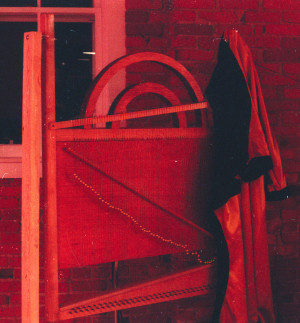Echo was first presented at The Garage in Montpelier, Vermont, in September 1985, with the composer performing.
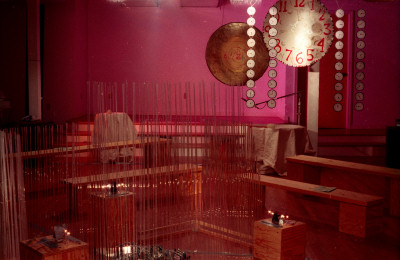
Throughout the performance, the audience is surrounded by sound from the tape mix, which comes from a minimum of four loudspeakers. The Nighthawk sculpture (Part IV) has a separate set of four speakers, also surrounding the audience from a different position. The action takes place within, around, and in the middle of the audience.
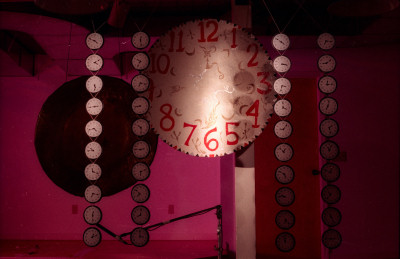
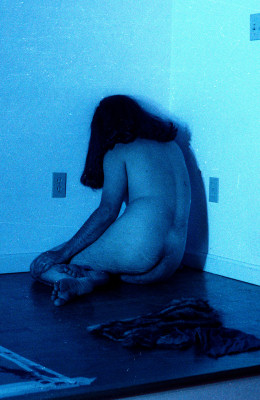
The chanter appears naked, crouched stage left, with his back to the audience; he is seemingly asleep. Dim blue lights wash the scene. The chanter wears long brown hair. Spring peepers are heard, gradually rising in volume with the blue lights. After several minutes, a howl is heard; the chanter awakens, but again drops off. A second, then a third howl is heard, to which the chanter responds with grunts and howls. Red lights of dawn slowly rise.
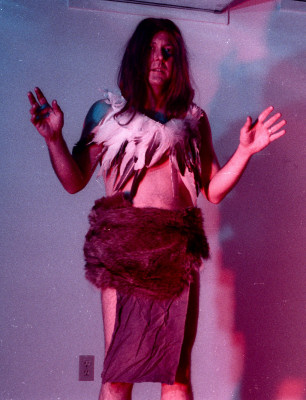
The chanter follows the cries, straightens to his knees, and spies a pile of fur on the ground. He howls louder, the red lights rise. He grabs the fur and smells it, eventually wrapping it around himself as a loincloth. Similarly, he spies a feather chest piece, smells it, and puts it on. The chanter stands erect; as the yellow wash brightens, he is bathed in white light.
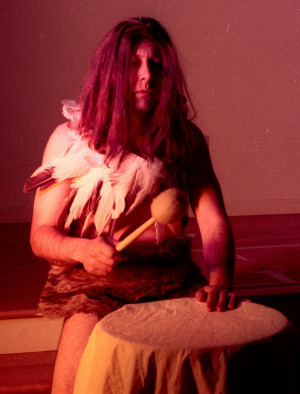
The chanterís cries begin to take form, almost as a melody. He listens carefully, discerning a distant group of drumming chanters. The chanter moves to a drum covered with muslin at the foot of the stage, and pounds it with his hands; he imitates the chantersí melody with his howls. Both drum and howls take shape, and soon he is pounding and crying with the distant chanters. As their sound grows nearer, the howls and eventually the peepers are no longer heard.
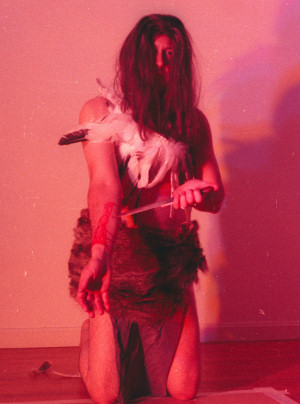
The chanterís own howl again takes over from the melody, and he moves away from the drum. In full view, he reaches for a knife and scars his arms. Blood flows profusely down his arms. He loudly combines howls and chants, lifts his arms to the skies, cries, and slowly walks off the stage. The chanters diminish, and the stage darkens.
Viols (tuned to D-sharp) are heard. A golden-robed figure in short, carefully kept hair walks to an altar to the left of the audience. The figure is illuminated by a single circle of light, and the altar is replete with delicate items: a wooden box, a gold chalice, a brass censer, a clay ocarina and a Chinese bell. All are set upon pure, fresh madras. As the viols begin an improvisation above D-sharp, the figure rings a bell (tuned to G-natural), plays an ocarina (tuned to D-sharp), and sings in imitation. The tune is a Ďcivilizedí version of the native chant just heard, but its purity is its disguise. He rings the bell once more to conclude the statement.
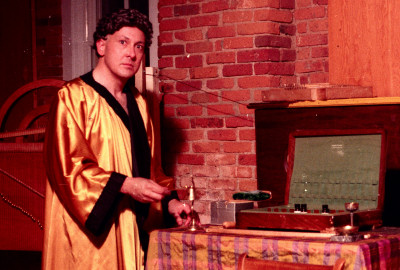
The figure reaches into a box of ritual elements, handing out dried lavender to nearby audience members. He pours oils of lemon and lime on the altar, and lights jasmine and frankincense. The viol improvisation once again circles around D-sharp as the pouring and burning conclude.
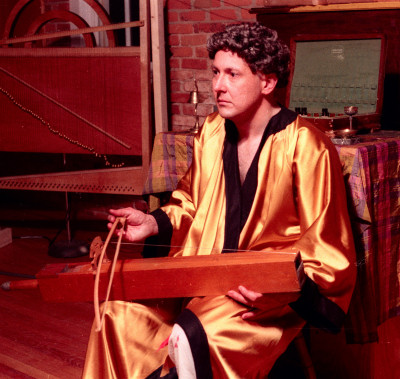
The figure sits, back to the altar and facing the audience, and plays the Monofilament, drawing the bow slowly and deliberately with a new accompaniment heard above the note G-sharp. He begins a vocal improvisation, locking eyes with audience members in turn. A rich pattern of G-sharp arpeggiation and modality is created, with occasional emphasis of minor seconds, minor sixths and major sevenths. Again, the vocal variation is on the original chant. The lengthy ritual concludes as the accompanying viols fade; the lights dim.
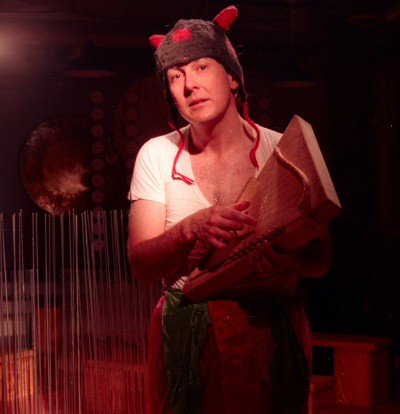
The figure removes the robe, hands it to a nearby audience member, and dons a jesterís horned hat. He is wearing a jesterís cloak and skirt below the robe. A general wash of light illuminates the jester and the audience. The jester picks up the triangulum and sings the interlude song, Ya Calleth That Music?, walking amidst the audience. The tune of this interlude song is an Elizabethan minor melody, and, like the evious scenes, is rooted in the original howls and chants. Upon the last arpeggio, the lights fade on this scene, and rise on the Infernal Machine in garish yellow. The Infernal Machine strikes its first percussion instrument.
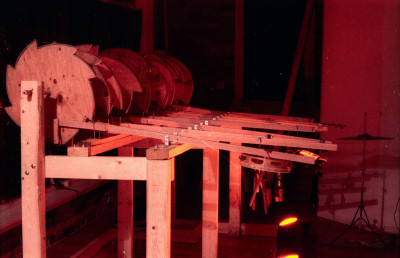
The Infernal Machine is located opposite the altar. The jester drops the outfit in darkness; underneath is a white workmanís suit. He dons a white work cap as well, walks out of the darkness to the Infernal Machine, and stares at it for a moment. The worker then releases the latches one by one, pausing to appreciate the new rhythmic pattern presented by the machine. He is relaxed, almost caricatured.
Homonym Text of The Infernal Machine
When all the latches are released and the machine is running its full percussion complement, the worker slips away in the darkness and moves to the clock stage. Forty clock faces showing different times hang from the ceiling, with a three-foot clock in the center; offset from it is a three-foot gong, and a three-foot drum covered in muslin appears below. The worker sits, and white spotlights illuminate him.
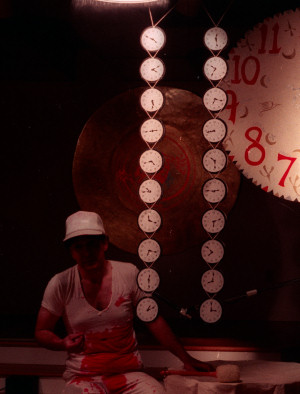
The worker begins to drum, slowly and erratically, until the Eastern War Time mix begins. He drums occasionally, listening, then begins a running commentary. This commentary begins ĎOf course youíve heard all that before,í and continues to remark about the sounds, the drumming, explosions, etc., before focusing on the Pietà. The worker speaks of Laszlo Toth with admiration, describing him jumping the velvet ropes and smashing the sculpture. He says he would stop the performance if Toth would appear, and asks if the audience would stop him (the worker) if the Pietà were on stage and he were to jump the ropes to smash it.
Night Thoughts Text for the Eastern War Mix
The drumming becomes regular and more frequent, with an occasional quiet gong strike. The worker then dismisses the possibility of the Pietà being there as fantasy, but notes that he is sitting upon a razor blade. He retrieves the blade, and the commentary then shifts to the worker as Pietà, the worker asking if the audience would stop him from using the blade on himself. After a time (assuming no audience comes forward), the worker slashes his chest with the blade. Blood pours forth; he drums and gongs wildly.
Victory Text for the Eastern War Mix
A train has been heard in the distance, and at this time it roars forward, children scream, explosions are heard, and there is a blackout. The Infernal Machine stops. The train is heard to recede in the distance.
The Kaddish for the Eastern War Mix
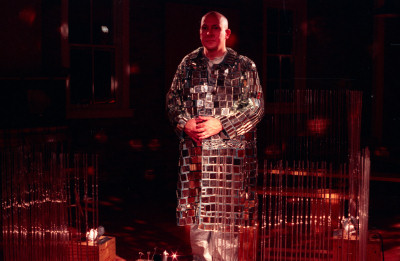
The lights slowly rise to a relatively dim level in the center, where a sculpture of glass rods (always visible but until now insignificant) is illuminated. The WindHarp fan turns on and the WindHarp, located on the periphery of the audience, begins to play quietly, lightly amplified. The Nighthawk electronic sculpture starts to sound softly.
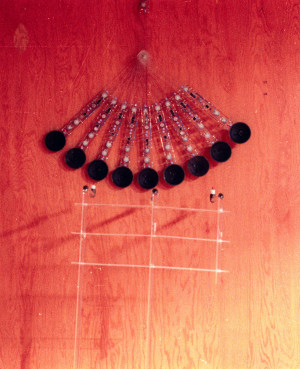
The futurist appears in a robe made of mirror, which clinks as he walks; his head is shaved. The WindHarp continues; the futurist may play as he passes. He walks toward the Bleebler -- in a far corner of the area -- and lights the candles in front of it; it begins to sound in response to the flickering.
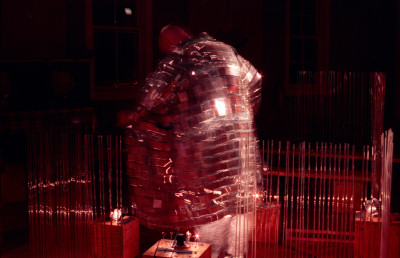
The futurist then walks to the center of the glass rod sculpture, and the tiny Nighthawk spotlights brighten. He stands in place, then begins a light dance, flashing the Nighthawk sculpture and the audience with the sixteen Nighthawk spotlights and the four center spots.
The dance continues, becomes more vigorous, then slows until the robe is dropped to the ground. The futurist is now in a silver suit. He picks up a box or basket of rattle chimes and walks among the audience, handing one to each person. When all the rattle chimes are handed out, the futurist picks up the robe and flashes it at the Nighthawk sculpture. At this point, the WindHarp, Bleebler, Nighthawk, mirror robe, and rattle chimes are creating the sound, shortly joined by a row of viols playing chord patterns in sliding harmonics.
The futurist backs into the darkness for a few moments as this sound continues. The lights go down in the center, leaving the Nighthawk lights, which are also dimmed slightly. Eventually he is seen sitting on stage, gently illuminated, where he begins a vocalise combining the elements of the chants, the songs and the phrases heard throughout the piece. Gradually the WindHarp, Bleebler, Nighthawk, and viols disappear one by one.
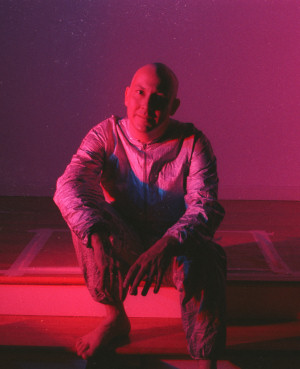
The peepers return, joining the sound of the audience shaking the rattle chimes. The futurist continues the vocalise for a few minutes while the combination is explored and resolved; he is smiling and genuine. Eventually the lights redden and he leaves the stage singing; he continues singing offstage until the vocal work is completely resolved.
The peepers remain, as do the rattle chimes, for a few minutes. The peepers fade, the lights dim to blue and black. The only sound is that of the rattle chimes, which continues as long as the audience allows.
